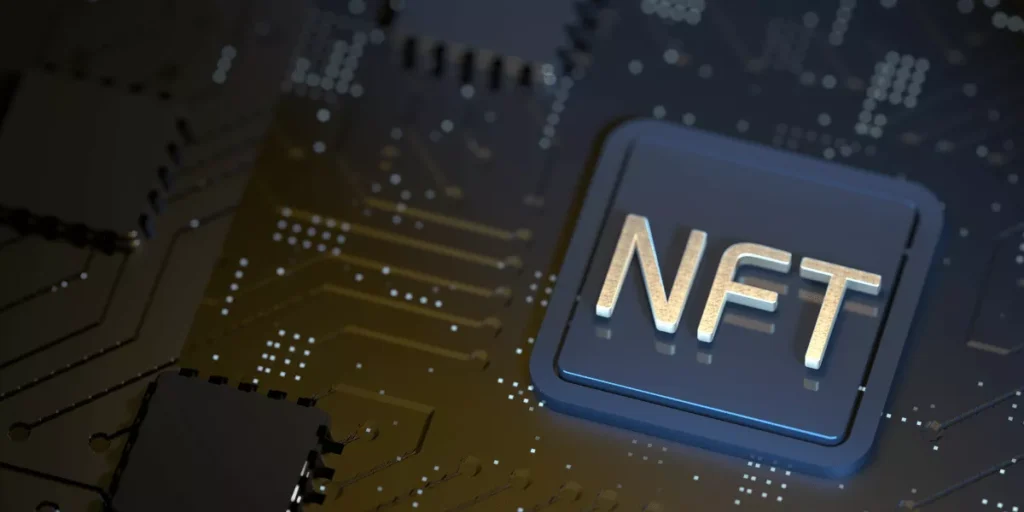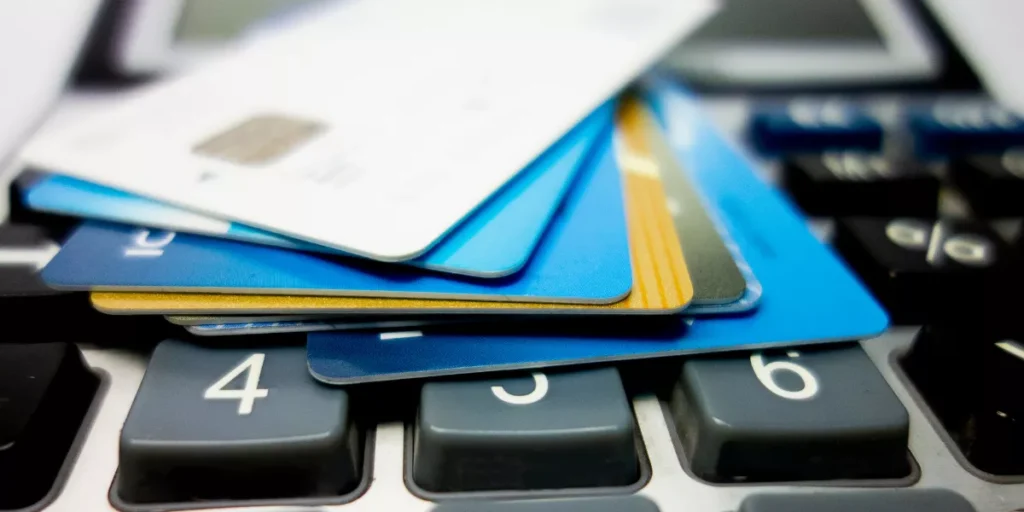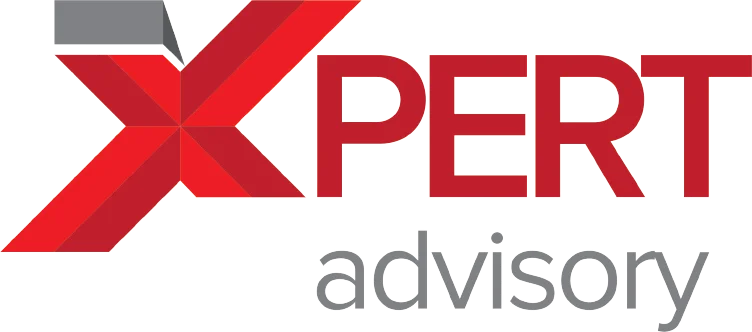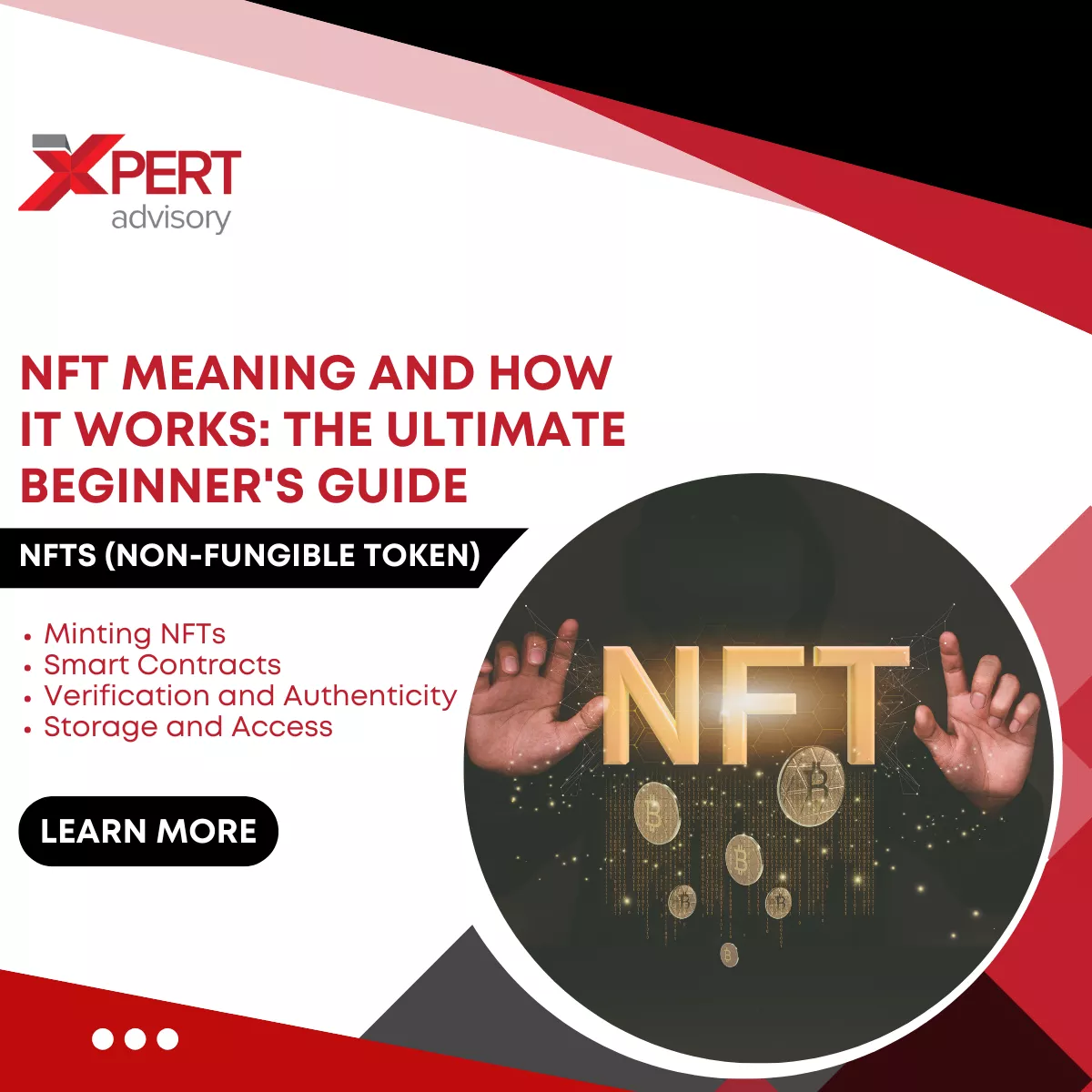Have you ever wondered how people buy and sell works of art, music, or virtual real estate online? The technology behind this is fungible token or NFTs.
Whereas regular digital files might be duplicated indefinitely without reducing their value, NFTs can only exist as unique pieces and hold real value in the ‘digital’ marketplace.
NFTs have recently been incredibly popular, but what exactly are they, and why can sellers get so much for these tokens? In this guide, we’ll discuss the NFT meaning and how it works in detail. So, let’s get into it!
What Does NFT Mean and How Does It Work?
Before getting into the world of NFTs creation and marketplaces, let’s first start from the basics, like the NFT meaning and how it works:
NFTs (Non-Fungible Token) Definition

NFTs stands for non-fungible tokens that are represented as digital artist pieces, digital content, or video tokenised using a blockchain. Metadata is turned into an encryption function to create unique identifier codes known as tokens. These are then stored on the blockchain, and the actual assets are stored elsewhere. What makes them unique is the connection between the token and the asset.
They can be traded and exchanged for money, cryptocurrencies, or other NFTs. For example, you could draw a smiley face on a banana, capture it (with metadata attached), and tokenise it on a blockchain.
NFTs Working Explained
Here’s how it works:
- Minting NFTs: What we call “minting” is creating an NFT. It consists of uploading a digital file (image, audio, video, etc.) to an NFT platform and a blockchain entry saying this is my file. Information, including the creator’s identity, ownership history and other relevant metadata, is embedded in the minting process.
- Smart Contracts: Smart contracts power NFTs, which are self executing contracts with the terms of the agreement written into code. Details of these contracts can include a royalty, where creators make a percentage of future sales.
- Verification and Authenticity: The information about the origin and history of NFTs are generally available and can be verified on the blockchain. Because of this, the authenticity and ownership of digital works can be determined in a verification-free setup.
- Storage and Access: While the blockchain stores the NFT, the digital file – picture, song, whatever it might be – can be stored anywhere. Hence, the NFT represents ownership of a digital file. Also, it allows the owner to access or use it.
What are the Properties Of a Non Fungible Token?
The United Arab Emirates NFT market is expected to generate a revenue of US$3,220.0k by 2024. So, if you’re interested to invest in blockchain works, have a look at their unique features:
- Digital Uniqueness: Unlike cryptocurrencies like Bitcoin or Ethereum, NFTs are unique. This is unique, like a digital signature or certificate of authenticity for every token.
- Non-Interchangeability: Non-fungible token stands for each unique token that can’t be exchanged like regular currency on a one-to-1 basis. However, the value of NFTs are individualised and depend on variables like scarcity, utility and wanting.
- Blockchain Technology: NFTs use blockchain that is also known as Ethereum technology. A decentralised ledger of transactions is the blockchain. In this case, there’s transparency, and they’re secure, unable to duplicate or make a forgery of the NFTs.
- Ownership and Transferability: An NFT is digital ownership of a particular item or piece of content, and you own it. NFTs work is verified and recorded on a blockchain, making it simple to transfer or trade NFTs while staying clear of its history.
Examples of NFTs

You can use NFTs to buy Cryptokitties. Cryptokitties are digital kittens with identities on the Ethereum blockchain, created in November 2017. Every kitty is individual and has the right price. They recolonise among themselves and generate versions with attributes and valuation coefficients other than those of their “AS” parents.
It took only a few weeks since the launch of cryptokitties to receive legions of fans willing to spend millions of ether on acquiring cryptokitties and their feeding and training. Most of the earlier market for NFTs was relatively limited to digital art and collectives, but the market is much more than that now. Following are the most popular NFT examples:
- Photography: Photographers can also convert their work into a token on the blockchain, and people can buy total or partial ownership of a piece.
- Sports: This is a collection of digital art based celebrities and sports personalities.
- Trading cards: Digital assets collectible trading cards originate from tokenisation. Some items are collected, and others can be used in gaming, where they earn you credits for the type of item.
- Utility: Here NFTs are used to grant access or offer service rights.
- Virtual worlds: NFTs are digital assets in the Virtual Realms including avatars, wearables, collectibles, plots of virtual land, and anything you could imagine with the help of NFT.
- Art: The generalised category of NFT art, including all from pixel to abstract art.
- Collectibles: Examples of NFT collections in this category, such as Bored Ape Yacht Club, Crypto Punks or Pudgy Panda.
- Domain names: Pure ownership of a domain name for your website is represented with the best NFT.
- Music: It currently allows artists to tokenise their music, thus giving the buyers licenses of the rights the artist wishes to assign.
How to create an NFT?
Following are the steps by which NFT is created:
- First, you can choose any wallet from four different types, each with its own cost, security and device for access.
- To make a non-fungible token, you need to add cryptocurrency you can use to pay the fees.
- Now, you have to connect your wallet to an NFT marketplace.
- Finally, you must list your item in an NFT marketplace so others can see it.
Starting a new NFT is not all that different from starting a new Instagram account and posting a few pics. You can also completely skip the whole copyrighting process, as copyright is established when you create the NFT. To create an NFT usually costs between $1 and $500.
How to Buy an NFT from the Marketplace?
You can’t buy NFTs without having an account on an NFT marketplace and an associated crypto wallet. In a specific marketplace, you will have to top up your wallet with a cryptocurrency from the particular blockchain or your debit or credit card. After that, you can bid on the NFT you want to buy at a fixed price if it’s listed that way.
Here is the process for purchasing NFTs on a marketplace like OpenSea:
- Open a crypto wallet acceptable to OpenSea; examples are MetaMask and Coinbase Wallet.
- To OpenSea, connect your crypto wallet.
- Browse the available NFTs.
- To buy one, click Buy now when you find one.
- Choose your payment method: crypto or card.
- Look at the fees and fine print, and then click Pay to confirm your order.
Where Can You Buy NFTs?
NFT marketplaces are the best place to buy and sell NFTs, and there are three types:
- Open NFT Marketplaces: NFTs are sold on these marketplaces and anyone can use them. Imagine it’s a completely social dog, that’s why you can have a good social life and meet many people, but everything you look at has money value.
- Closed NFT Marketplaces: These are also called curated or premium marketplaces. This means you must be invited to apply on the marketplace to list an NFT. This marketplace has strict rules. At every sale, it gives royalties to the original artist and works with traditional art collection communities to hold the spirit of curation.
- Proprietary NFT Marketplaces: The art traded is completely in the hands of the proprietary marketplace, such as Bored Ape Yacht Club. With events and limited runs, these marketplaces are building a brand. There are ten thousand Bored Ape NFTs added to the blockchain of Ethereum.
Here are some more famous NFT marketplaces where NFTs are stored:
- Rarible
- Foundation
- Nifty Gateway
- NBA Top Shot
- Quint
- Binance NFT
- Coinbase NFT
- SuperRare
What Is the Future of NFTs? Are They Safe to Buy?
The future of NFTs is completely safe. They’re stored on a blockchain technology. Like any other standard art, if you buy an NFT, you must also take care of it to keep it secure. The biggest security issue you have to worry about is fraud.
The storage of NFTs is on a complex infrastructure that’s almost impossible to cheat. As long as you have the private key, you have absolute control.
What are NFT scams?

Following are some common NFT scams:
- Catfishing
- Phishing
- Free mint scams
- Rug pull scams
- Trading scams
- Plagiarized NFT scams
- Website scams
- Pump and dump (P&D) scams
- Tech support NFT scams
How to Prevent NFT Scams?
The following steps must be taken to avoid NFT scams:
- Take care of your transactions.
- Try the most trusted digital wallets and marketplaces.
- Before you purchase NFTs, always do research on them.
- Know your market and know the risk.
- Your cryptocurrency and NFTs should be stored in cold wallets.
- Use good digital hygiene such as long, strong passwords and 2 factor authentication.
- Make sure that you have comprehensive online security software to protect you from threats.
Final Words
Understanding the NFT meaning and how it works is key to knowing the increasing world of digital assets. With NFT ownership, we have a different way of securely buying, selling and trading digital creations via blockchain technology. Moreover, uses of NFTs offer exciting opportunities for artists, collectors, and investors alike. But it’s important to stay knowledgeable and stay on your guard to avoid scams and get the most out of this new technology.
Are you ready to grow your business to the next level? We at Xpert Advisory Dubai are here to provide your business with customised solutions that can help your business succeed. We bring everything from business set-up and accounting services to a VA consultancy and financial planning under one roof. Contact us now and let our experienced professionals back you in Dubai’s competitive market!
FAQs
How NFTs Make Money?
When you buy or sell NFTs, the creator gets a portion of the sale price of the NFT itself. This becomes a never-ending royalty in the future. Moreover, these royalty percentages usually range from 5% to 15%.
Is Investing In NFT A Good Decision?
NFTs are real-world assets on the blockchain. While NFTs grant ownership over an asset, it remains affected by problems of counterfeiting, fraud, and money laundering.
How Can You Convert NFT To Money?
You can transfer the cryptocurrency from your wallet to a cryptocurrency exchange. Binance, Coinbase and Kraken are all popular exchanges. Exchange your crypto into the fiat. Not only do exchanges allow you to exchange cryptocurrencies for other cryptocurrencies, but you can also convert your crypto to fiat.
How Much Do NFTs Cost?
Creating an NFT costs in several ways, and the price depends on the blockchain and the NFT marketplace like Opensea. The cost of one NFT is as low as $0.05 or as high as over $150 per NFT.
What Is The Difference Between NFT And Cryptocurrencies?
The major difference between NFTs and cryptocurrencies is their fungibility. Cryptocurrencies, such as Bitcoin, are fungible. One Bitcoin is as good as the next. Each NFT is unique and non–fungible, like works of art. For the most part, cryptos act as digital money, and NFTs are the owners of unique digital assets on a blockchain.


